Unless you’re a celebrity or a macro influencer whom people highly trust, you can’t have a thriving online business in 2024 without a sales funnel in place.
No matter how effective your marketing is and how much you spend on it, you will always get more cold leads than hot ones, so you must have something that moves cold leads down the sales funnel and turns them into customers.
The typical buyer journey starts with realizing they have a problem (or a need) and ends with making a purchase to solve it. This journey typically has 3 to 15 steps, which can take anywhere between a few minutes to a few weeks, depending on the price, the industry, the temperature of leads, and the business model (B2B or B2C).
This article will help businesses ensure that they make the most of their traffic by optimizing their sales funnel for more conversions and better profits in the year ahead!
Table of Contents
Which stage of the sales funnel should I focus on?
What content should I create for each stage?
The bottom line
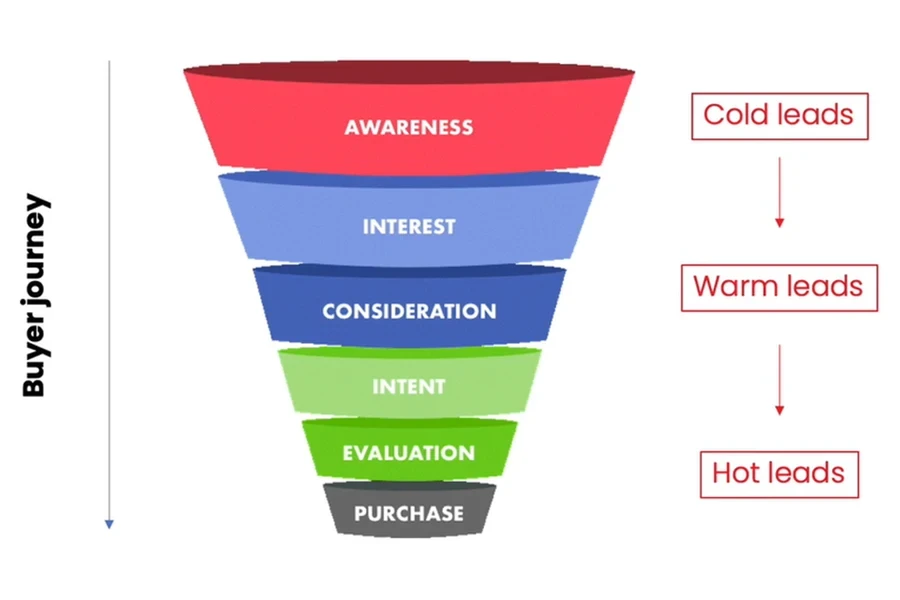
Which stage of the sales funnel should I focus on?
Statistically, it’s estimated that about 27% of leads are hot while the remaining 73% are cold or warm. Those percentages are close to the larger market formula which states that a market in general has four parts:
- 60% of people are not problem-aware (cold leads)
- 20% of people are problem-aware (cold to warm leads)
- 17% of people are in the information gathering mode (warm to hot leads)
- 3% of people are in the buying mode (hot leads)
The best way to take your leads to the next level is to provide the right content for each stage. This means having a content funnel that offers personalized and valuable content that keeps your prospects engaged until they become loyal customers, but it doesn’t necessarily mean you must distribute your content creation effort equally across all stages.
Thinking that everyone starts at the top of the funnel as a cold lead and then makes their way down the funnel is a common mistake. In reality, this is no longer the case.
In theory, most leads will start at the top of a funnel but it doesn’t necessarily have to be your funnel; they probably started the journey already and became problem-aware through the funnel of your competitor.
Another common mistake is to think that all leads are similar as long as they’re all in the same stage of the sales funnel; you can actually find multiple segments of leads at the same stage of the funnel.
Bottom-up or top-down?
There is a debate over which direction businesses should take. Should you start from the top of the funnel and make your way to the bottom (top-down), or should you start at the bottom first and then make your way to the top (bottom-up)?
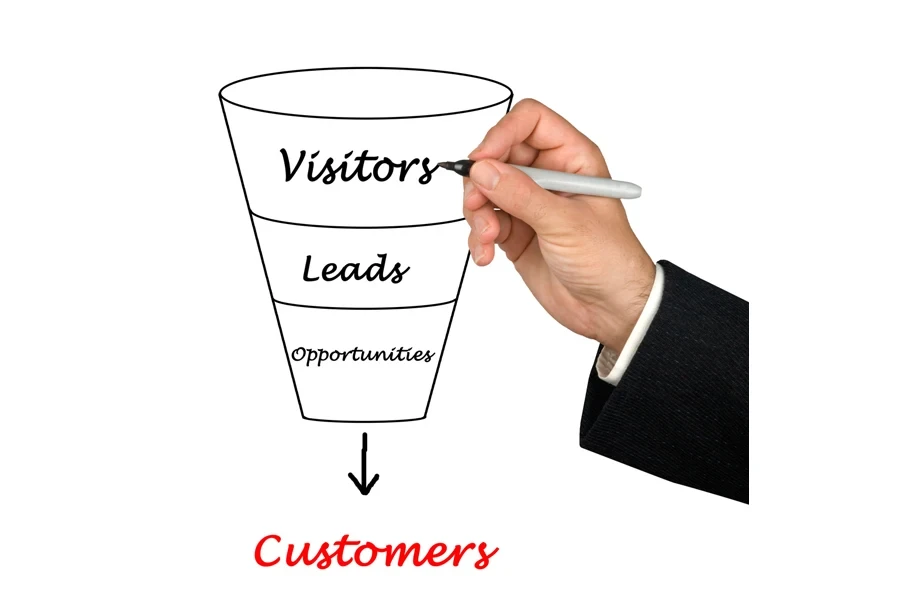
There is no right or wrong answer. It depends on your niche, goals, budget, etc. Here are some facts to consider:
- Top-of-the-funnel leads have a 47% lower conversion rate
- Bottom-of-the-funnel advertising costs 35% more
- The ads in both strategies have almost the same CTR
If your goal is to increase sales in the next few months and you have the budget, you will need to focus on the bottom of the funnel, but if your goal is to build brand awareness and visibility, then you should focus on the top of the funnel.
It’s also recommended to focus on a specific part of the market depending on your industry. There are industries and niches where all competitors are fighting over the 3% hot leads, while in other niches there is an oversupply of educational content that speaks to the 60% and almost nothing that speaks to the hot and warm part of the market.
Know your goal, do a competitive content analysis so you can identify where you can stand out, and also study your leads and their most common temperature when they come across your website (or social media pages) for the first time. You can survey your leads, collect relevant data, and use chatbots to learn the maximum you can about your leads.
What content should I create for each stage?
Turning those strangers who enter your funnel into customers (and hopefully recurrent customers) takes a deep understanding of their needs. When you choose the stage you want to focus on, a great way to start is to understand your leads’ search intent and what they look for.
We can approximately assign each one of the four primary search intents to a market part as shown below:
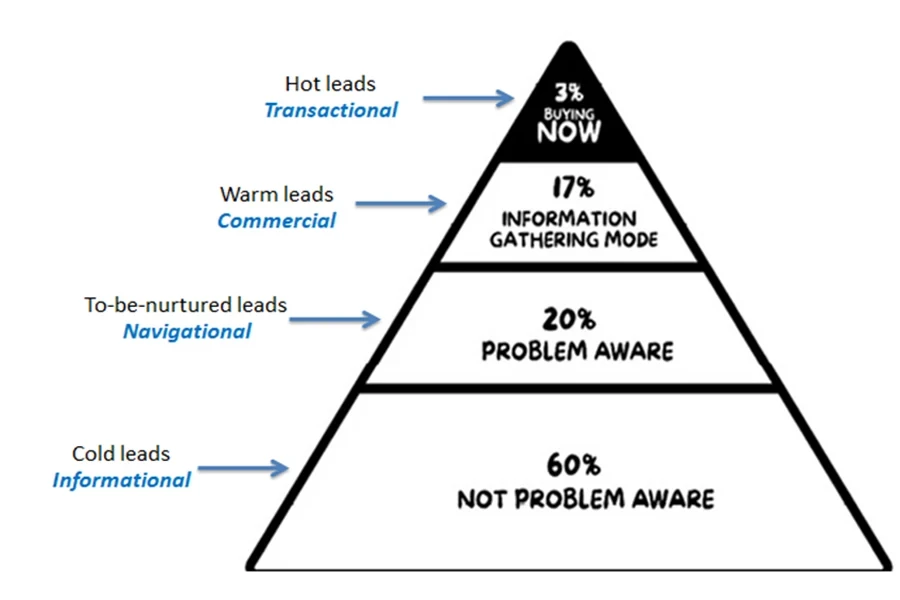
Top of the funnel (TOFU)
This is the earliest stage of the customer journey. Here, your lead has just come across your website or social media pages and is either:
- Not problem-aware at all => awareness focus
- Somewhat problem-aware, but not ready to make a purchase yet or even look for products => interest focus
These two segments might seem different, but they almost have the same intent and they’re both seeking knowledge and interested in the topics related to your niche/products.
Even though the first one might have a larger share in theory, keep in mind that, unless your product is a completely new category and one of a kind, your product has some alternatives and it’s likely solving a problem that already has other solutions.
This means that although creating educational and informational content is crucial at this stage, maybe your competitors and other content creators have already educated many of your prospects (which is how the second segment appeared).
The best thing to do is to avoid basic and generic educational content, and this means you can actually create the same content for both segments. Avoid the average educational content that doesn’t stand out and try to mix awareness with interest. Here are some tips on how to do that:
- Value-based marketing
Make sure that you go a step further and provide at least 10% more value than your competitors. If your competitors’ content revolves around the What, create content about the What + Why. If they create content about the What + Why, create content about the What + Why + How.
Try to educate your leads in new and creative ways, use relevant and real stories to highlight the problem, correct common misconceptions in your niche and highlight how they complicate the problem even more, and help them to get clarity on what they need to solve their problem.
- Omnichannel marketing
Most people tend to shift between multiple platforms and websites throughout the day, and it’s easy to lose cold leads if you make them feel they have to go there and then click here and then there to understand your message and content.
Instead, keep their interest by providing an easy navigation experience supported by well-thought-out content that offers them everything they need at their stage. Think of creating a knowledge base, FAQs, carrousels, or a series of videos or posts that answer their questions and keep them interested and curious.
- Brand personality
You don’t want to just educate your leads (your competitors can do that), you want your leads to build an emotional connection with your brand.
Make sure that your brand story, mission, and positioning are present in your educational content in a way that piques their interest and fosters connection. The point is to tell them the vision and make them care.
Sales and products should not be in the picture at this stage. People are just looking for initial information about their problems or needs. You only need to prepare them for the next stage where you will talk more about your products.
MOFU (middle of the funnel)
Only people with high interest will move here and there will also be some leads that drop out from others’ funnel and get to yours. So, your leads now are warm and can be divided into two segments:
- People who got problem-aware and interested in your brand thanks to your TOFU content
- New people who don’t know a lot about you but are problem-aware and decided to look for a solution and found you somehow (aka. information-gathering mode)
Both of them need a business that understands them and helps them make the right decision. These people are not sure who they can trust because they are still doing the research, discovering the market, and just starting to compare products and offers.
Prospects now need to know more about your products and need social proof, and you also need to nurture them and build a relationship with them. This makes content creation at this stage more flexible because there are no rules here; you can create educational content, talk about your products, promote your brand directly and indirectly, etc.
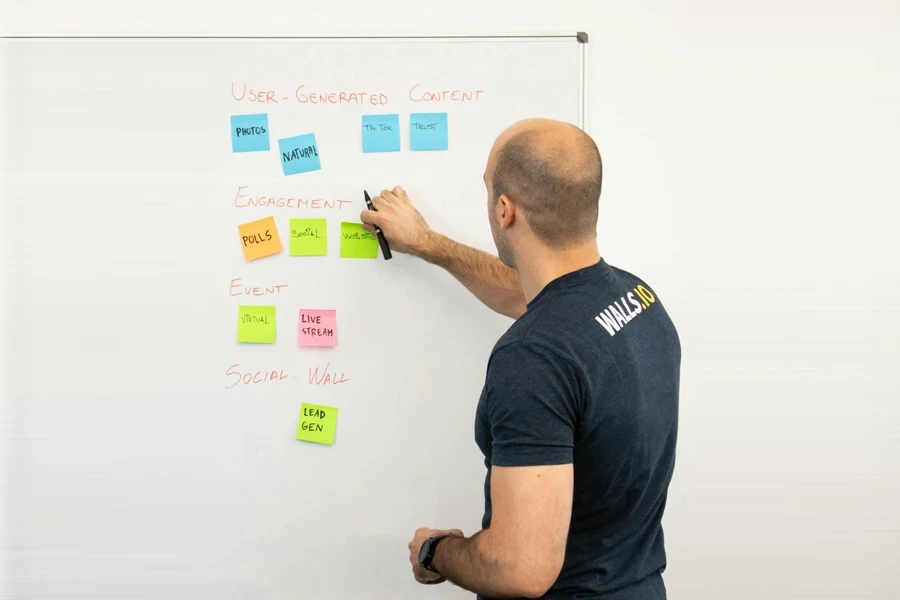
Here are the best ways to do that:
- User-generated content (UGC)
UGC is a great way to build trust and make people relate to your brand. MOFU leads need to know more about your products but not in a salesy way; try to show them how other people are using your product and it is now part of their daily life.
- Testimonials & reviews
Customer testimonials and reviews are also important to establish your social proof. Authentic reviews will help prospects trust you more and understand your products and how they help with their problem.
- Influencer-generated content (IGC)
Influencer marketing is also effective at this stage. IGC tends to perform better than business-generation content and you can leverage it to nurture your lead. Make sure to choose the right influencers and create IGC that shows how the product helps the influencer solve their problem.
Influencer marketing campaigns at this stage should not be about making more sales. The product should seem organically integrated into the influencer’s life and not a new thing that just enters the influencer’s life and wants to promote it just for money.
- Thought leadership content
At this stage, people need more advanced knowledge compared to TOFU. In general, people are more likely to buy from a business they perceive as an expert. So make sure to educate your prospects about your industry, the challenges and opportunities that exist, the updates and new trends, etc.
Make sure to also educate them about your specific offering, how it stands out, and what your product or offer does differently. Help them understand how all of that works so they can be equipped to make the right choice.
- Newsletters
Email marketing is the most effective way for lead nurturing (72%). Newsletters are important in MOFU; make use of them to provide exclusive value, present the ins and outs of your value proposition, and build a lasting relationship with your prospects.
- Behind-the-scenes content (BTS):
People will relate to your business more and have a deeper connection with it when you share some behind-the-scenes. Give your warm leads a glimpse into your brand’s inner workings, daily operations, special moments with the team and exclusive looks at how your products are manufactured or shipped.
Bottom of the funnel (BOFU)
At this stage, you will mostly have hot leads that are either:
- People who are in the buying mode now and ready to buy from you
- People who are close to buying. They want to purchase the right solution and are considering you (but maybe not only you)
For the first segment, they’re willing to buy from you and they only need extra push to take the action. Some social proof with a good offer or special discount is enough to convert them.
For the second segment, they still need a bit more nurturing. Make sure to highlight your competitive advantage, present detailed case studies, and present social proof that shows your product’s benefits and highlights how it transformed your customers’ lives. Focusing on the transformative aspect of your product is important at this stage.
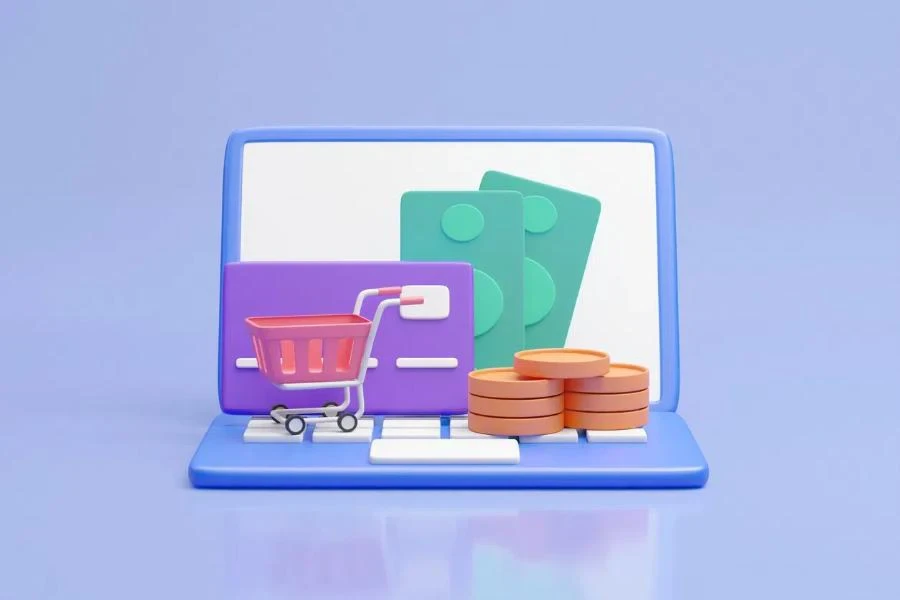
Read also:
- How to Use Pain Point SEO to Grow Your E-commerce Business
- Buyer Intent Keywords Convert Better. Here’s How to Find Them
The bottom line
The customer journey is not always linear. Your funnel will receive different leads with different needs and temperatures, and you should be strategic about who and how to target and also how to create content for each stage. Remember:
- Cold leads need awareness and education about the problem and your brand
- Warm leads need to trust your brand and build a relationship so you can move closer to a purchase
- Hot leads are ready to buy and need clear and convincing reasons to choose your brand
By optimizing each stage of your sales funnel, you’ll be sure to succeed in converting leads and increasing your sales in the year ahead!




